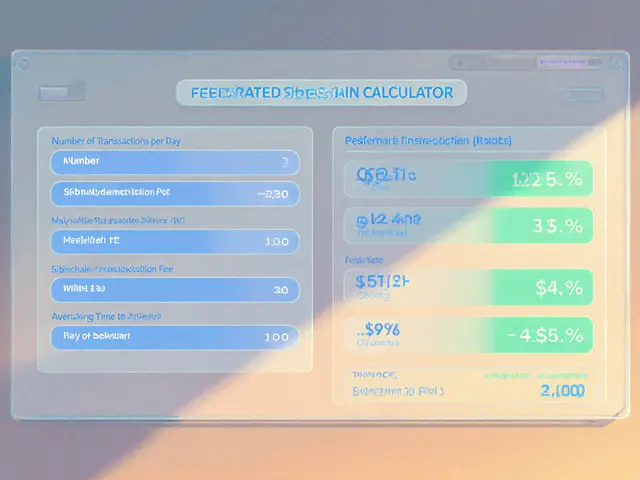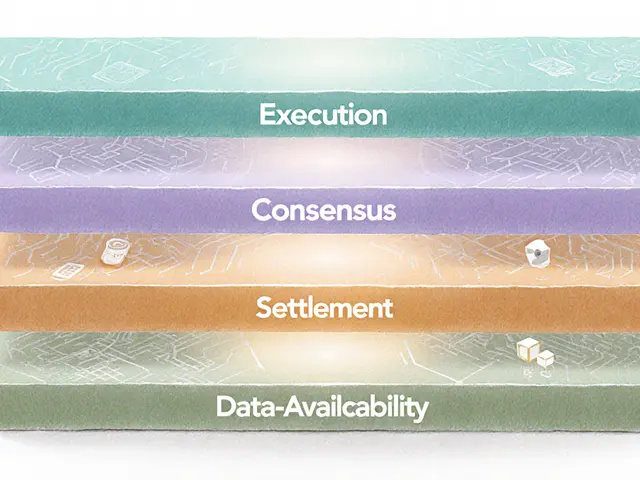Federated Sidechains Explained: How Bitcoin’s Scalable Sidechains Work

Federated Sidechain Calculator
Transaction Parameters
Estimated Benefits
Daily Cost on Mainchain:
$0.00
Daily Cost on Sidechain:
$0.00
Daily Savings:
$0.00
Time Efficiency Gain:
0 seconds
Key Benefits Summary
- Transaction Speed Sub-second
- Transaction Cost ~$0.0005
- Security Model Federated Multisig
How Federated Sidechains Work
Federated sidechains enable efficient Bitcoin scaling by creating a secondary blockchain that locks and releases Bitcoin through a trusted consortium. Here's the process:
- Users lock BTC on the main Bitcoin chain
- The federation releases synthetic tokens on the sidechain
- These tokens can be used for fast, low-cost transactions
- To return to mainchain, tokens are destroyed and BTC unlocked
This approach allows for higher throughput and lower fees while maintaining Bitcoin's core security model.
Ever wondered how Bitcoin can handle more transactions without changing its core protocol? The answer lies in federated sidechains - separate blockchains that lock and release Bitcoin via a trusted consortium. They let developers experiment, scale, and add features while keeping the main network safe.
What Is a Federated Sidechain?
In the world of crypto, a federated sidechain is a parallel blockchain that connects to a parent chain (usually Bitcoin) through a two‑way peg managed by a known group of operators. Unlike independent altcoins, a federated sidechain doesn’t issue its own native coin; it merely mirrors Bitcoin’s supply by locking real BTC on the main chain and issuing a matching token on the sidechain.
How the Two‑Way Peg Works
The peg is the bridge that moves value back and forth. When you want to use Bitcoin on a sidechain, you send it to a special output address on the mainchain. After a set number of confirmations, the federation releases an equivalent amount of tokens on the sidechain. To move the coins back, you send the sidechain tokens to another designated address, effectively destroying them and unlocking the original BTC on the main chain. This creates what experts call synthetic assets - tokens that represent real Bitcoin but live on a different ledger.
Federation Mechanics: Trust, Multisig, and Block Production
The security of a federated sidechain rests on the federation itself - a group of publicly known entities that jointly manage the peg. Each member holds a share of the locked Bitcoin using multisig (e.g., a 2‑of‑5 scheme). To issue or burn sidechain tokens, a threshold of signatures must be collected, ensuring no single actor can unilaterally move funds.
Block creation on the sidechain doesn’t involve proof‑of‑work. Instead, federation members sign new blocks with their cryptographic keys. Because signing is cheap, transaction finality can be achieved in seconds and fees drop to just a few satoshis.
Synthetic Assets: The Token‑Backed Representation of Bitcoin
When BTC is locked on the main chain, the federation mints an equal‑valued token on the sidechain - often called a "pegged Bitcoin" or "synthetic asset". These tokens behave exactly like Bitcoin within the sidechain environment: they can be sent, received, or used in smart contracts. If the sidechain token is destroyed, the corresponding BTC is released, keeping the total supply constant across both ledgers.

Efficiency vs. Decentralization: A Trade‑off Overview
Federated sidechains sacrifice some of Bitcoin’s extreme decentralization for speed and cost savings. The trade‑off looks like this:
| Attribute | Federated Sidechain | Proof‑of‑Work Sidechain | Bitcoin Mainchain |
|---|---|---|---|
| Consensus | Federation‑signed blocks (multisig) | Proof‑of‑Work mining | Proof‑of‑Work mining |
| Decentralization | Medium - depends on federation size | High - open mining | Very high - global miner network |
| Transaction cost | Few satoshis | Low to moderate (depends on hash rate) | Higher (network congestion) |
| Finality time | Seconds | Minutes to hours | 10 minutes + confirmations |
| Security model | Federation custody + multisig | PoW security similar to mainchain | Strongest PoW security |
Because the federation is known and limited, attacks are easier to coordinate than against a global mining network. However, for many applications the speed and low fees outweigh this risk, especially when the main chain remains the ultimate fallback.
Practical Use Cases for Federated Sidechains
- Scalable transaction processing: Offload high‑volume payments to keep the Bitcoin main chain from bottlenecking.
- Smart‑contract experimentation: Deploy ERC‑20‑like contracts without touching Bitcoin’s limited script set.
- Privacy‑focused transfers: Use confidential transaction techniques on a sidechain while preserving BTC on the main chain.
- Regulatory compliance: Build KYC/AML checkpoints within a permissioned federation for institutions that need audit trails.
- High‑frequency trading: Execute rapid order matching with sub‑second latency and settle on Bitcoin later.
Security Considerations and Risks
The biggest question is: can you trust the federation? Security hinges on three factors:
- Diversity of members - A geographically spread, publicly known set reduces collusion risk.
- Threshold signature design - Requiring multiple signatures (e.g., 3‑of‑5) makes unilateral theft impossible.
- Auditability - Transparent logs and on‑chain proofs let anyone verify that locked BTC matches sidechain supply.
If any of these pillars weaken, the sidechain could become a target for attacks, potentially leading to loss of the pegged assets. That’s why many projects treat the sidechain as an experimental layer, keeping the main Bitcoin network untouched.
Future Outlook: From Federated to Decentralized Pegs
Today's federated sidechains are a stepping stone. Researchers are already prototyping decentralized two‑way pegs that rely on simple payment verification (SPV) proofs instead of trusted custodians. Such upgrades would let anyone verify that the Bitcoin locked on the main chain matches the sidechain supply, dramatically improving trust while preserving speed.
Until those solutions mature, federated sidechains remain the most practical way to bring new features-like tokenized assets, faster payments, and programmable contracts-to the Bitcoin ecosystem without compromising its core security.
- Lock BTC on Bitcoin.
- Federation releases synthetic tokens on sidechain.
- Use tokens for fast, cheap transactions or smart contracts.
- Destroy sidechain tokens to unlock original BTC.
Frequently Asked Questions
What differentiates a federated sidechain from a regular Bitcoin fork?
A regular fork creates a completely independent blockchain with its own consensus and token. A federated sidechain stays linked to Bitcoin through a two‑way peg, allowing BTC to move in and out while sharing the same maximum supply.
How secure is the multisig custody used by federations?
Security depends on the number of participants and the signature threshold. A 3‑of‑5 multisig with well‑known, geographically dispersed members provides strong protection against a single malicious actor.
Can I use a federated sidechain for private transactions?
Yes. Some federated sidechains implement confidential transaction protocols or ring signatures, giving users privacy while the base Bitcoin stays fully transparent.
What happens if a federation member goes offline?
If the offline member is not part of the required signature set, the sidechain continues operating. Redundant members and a well‑chosen threshold ensure resilience.
Are there any live examples of federated sidechains today?
Yes. Projects like Blockstream’s Liquid Network and the earlier Elements sidechain are operational federated sidechains that handle millions of dollars in daily volume.








Federated sidechains give Bitcoin a practical scalability path without touching the base protocol, letting developers experiment while keeping the main chain’s security intact.
They can shave transaction fees to a few satoshis and push finality down to seconds, which is a win for everyday users.
From a global viewpoint, sidechains act as sandbox environments where different jurisdictions can test regulatory‑friendly features before they ever touch the mainnet.
That collaborative approach can foster broader adoption across borders.
Here’s a quick rundown: lock BTC on‑chain, the federation mints a pegged token, you transact cheap and fast, then burn the token to unlock the original coins.
🪙✨ It’s essentially a “Bitcoin‑in‑a‑box” that you can spin up for specific apps.
Feel free to tweak the fee sliders and see the savings yourself!
The security model hinges on a multisig threshold – think 3‑of‑5 or 2‑of‑3 signatures – which distributes custody across known operators.
Such a custodial aggregation mitigates single‑point failure while still enabling sub‑second block finality, a trade‑off many deem acceptable for high‑throughput use cases.
Think of the federation as a relay team: each member runs a short leg, handing off the baton (the locked BTC) quickly and efficiently.
When one runner stumbles, the others keep the race going, ensuring the chain stays alive and fast.
Another overhyped sidechain hype.
While federated sidechains provide convenience, we must remember that delegating custody to a limited set of entities reintroduces a centralization vector.
Ethical design should demand transparent audit logs, robust multisig thresholds, and a clear exit strategy back to the trustless Bitcoin mainnet.
Low‑fee, high‑speed transactions are not just a nice‑to‑have; they’re essential for micro‑payments and DeFi primitives that can’t survive Bitcoin’s ~10‑minute block time.
Federated sidechains give us that missing layer without compromising on security guarantees.
The paradox of blockchain evolution is that every gain in velocity tends to pull us away from pure decentralization.
Yet, when we stride forward with federated peg mechanisms, we deliberately accept a measured loss of trustlessness for a massive boost in usability – a philosophical compromise worth contemplating.
Sidechains add throughput, lower fees, and enable smart‑contract experimentation while Bitcoin stays as the ultimate settlement layer.
Use cases like rapid NFT minting, confidential transfers, or high‑frequency trading can thrive on these sidechains, letting Bitcoin act as the final arbiter of value.
Our nation has the technical talent to run a secure federation; by doing so we can showcase home‑grown innovation and keep capital within our borders.
It’s interesting to see how quickly projects are adopting liquid‑like solutions; the community seems ready for a layer that handles daily commerce without the usual bottlenecks.
I love how federated sidechains strike a balance between innovation and security, offering a sandbox where developers can push the envelope without jeopardizing Bitcoin’s core.
First, the two‑way peg provides a clear on‑chain audit trail, so anyone can verify that the amount of synthetic tokens perfectly mirrors the locked BTC.
Second, the multisig federation reduces the attack surface compared to a single custodian, especially when the threshold is set thoughtfully (e.g., 3‑of‑5 with geographically diverse members).
Third, transaction finality in seconds opens the door for real‑time payments, which is a game‑changer for point‑of‑sale scenarios.
Fourth, the fee structure-mere satoshis per transaction-makes micropayments viable, something the mainnet simply can’t support at scale.
Fifth, because the sidechain uses block signing instead of proof‑of‑work, energy consumption drops dramatically, aligning with sustainability goals.
Sixth, developers can experiment with confidential transactions, tokenized assets, and even cross‑chain bridges, all while the main Bitcoin ledger remains untouched.
Seventh, the federation model still allows for governance upgrades; members can vote on protocol changes without hard‑forking Bitcoin itself.
Eighth, the transparency of on‑chain logs means that auditors can verify that no excess tokens exist, preserving trust.
Ninth, the ability to roll back or freeze a sidechain in case of a bug provides an additional safety net absent on the immutable main chain.
Tenth, the ecosystem around projects like Liquid demonstrates that real‑world value is already moving on federated networks, proving the concept works at scale.
Eleventh, the modular nature of sidechains means multiple independent networks can coexist, each tailored for specific applications such as DeFi, gaming, or compliance‑focused finance.
Twelfth, users retain the option to move back to the main chain at any time, ensuring that the sidechain never becomes a point of no return.
Thirteenth, the community can contribute to open‑source tools that simplify peg operations, lowering the barrier for new entrants.
Fourteenth, education around these mechanisms helps demystify Bitcoin’s scalability narrative for broader audiences.
Fifteenth, in the long run, federated sidechains could serve as stepping stones toward fully decentralized peg solutions, bridging the gap between trustless security and practical usability.
All in all, federated sidechains embody a pragmatic evolution of Bitcoin, preserving its core values while extending its capabilities into the modern financial landscape.
Sidechains just add more complexity; Bitcoin works fine as is.
The promise of “secure” federated pegs often masks the reality that trust is simply shifted, not eliminated, creating an illusion of safety that can mislead newcomers.
Stop ignoring the inherent risks of centralized federations; users deserve a truly trustless solution.
Great points! 😊 The low‑latency and cheap fees really open doors for everyday transactions, and the transparent audit logs keep everyone honest.
Your moral lecture feels out of place; the community has already established decent safeguards, and demanding perfection stalls progress.
While the optimism is infectious, we should also acknowledge that the current federation models still rely on a handful of operators, which could become a centralization choke point if not carefully diversified.